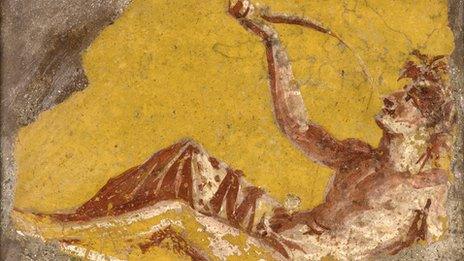Reviews: Life and Death in Pompeii and Herculaneum
- Published

Fragment of a wall painting showing a man reclining to drink
The British Museum's latest exhibition has received five-star reviews from critics.
Life and Death in Pompeii and Herculaneum displays the hidden treasures preserved for nearly 1700 years after Mount Vesuvius erupted in AD79.
With more than 400 objects on display, many have never been seen outside of Italy.
Here is a selection of reviews of the exhibition.
The Guardian - Jonathan Jones
The ash that buried Pompeii preserved its people. When the lost city started to be excavated in the 18th Century, cavities were found to bear spooky imprints of faces, flesh, clothes.
The 19th Century archaeologist Giuseppe Fiorelli discovered how to pour plaster of Paris into the recesses to create the terrible, beautiful statues of suffering that leave you so haunted by what is undoubtedly one of the most momentous archaeological exhibitions ever staged.
This majestic event will hopefully remind the world that Pompeii is not some tourist attraction to treat shabbily but the world's most revelatory survival of the human past.
The Telegraph - Richard Dorment
There have been other important exhibitions about Pompeii and an endless stream of books and TV programmes, so you may think you know what is coming next. I can only tell you that nothing I've seen or read before tells the story in the way the British Museum does.
For after reminding us of the terrible fate of the two cities, the curator uses a device familiar to us in films, when, after the opening credits fade, the words "TWO DAYS EARLIER" appear on screen. The exhibition goes back in time.
Thanks to the extraordinary generosity of the Archaeological Superintendency of Naples and Pompeii, the quality of much of what has come to London beggars belief.
The Times - Rachel Campbell-Johnston
This show sets a precedent in that it takes as its focus the domestic world. Each gallery is populated by a display of pertinent possessions: anything from the monumental street sculpture to the baby's wooden cradle, from the finest silverware to the terracotta cooking pot.
This exhibition offers an overarching view of a complex society... we glimpse their sense of humour, or understand their hopes or desires, or, in one poignant display case, see what they chose to try to rescue as they tried to make their doomed escapes.
It is the sense of these citizens as living, breathing individuals that will haunt visitors to this exhibition and bring the tears to their eyes.
The Independent - Michael Glover
Why is this marvellous retelling of the tragedy of the destruction of Herculaneum and Pompeii... so moving and so thought-provoking?
Because of the quiet, meticulous and unemphatic way it has chosen to concentrate our attention upon the story of the everyday, and, having done so, to conclude with a dramatic presentation of body casts of a selection of those who died.
Its triumph, then, is in its pacing. The story could easily have been told brashly and noisily from the start, accompanied by howls of piped anguish. Instead, the British Museum has opted to do something defter and more thought-provoking with the hellish tale.
- Published25 March 2013
- Published23 November 2012